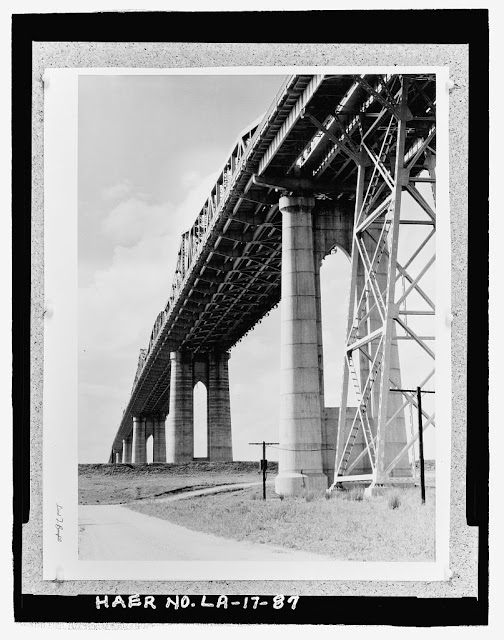 |
| Library of Congress |
During the late 1920s,
Louisiana was one state whose drivers finally climbed out of the mud (or
“gumbo”). Its history illustrates not only the fact that the automobile
preceded road development but also that politics proved critical to the story.
Like the rest of the nation, Louisiana witnessed an upsurge in car ownership
beginning in the early 1920s. For example, in 1922, there were 122,000 motor
vehicles registered in the state, but by 1924 that figure had risen to 178,000. In 1920, a state highway commission had been established, but it was poorly
funded and staffed, and the state’s elite patrician leadership was conservative
in raising the monies necessary to build a comprehensive state road system.
Given the climatic and geographical difficulties associated with the state –
for example, there were more than 5,000 streams and rivers in Louisiana – its
citizens were limited in where they could take the new cars they had purchased.
In Orleans Parish alone there were 43,000 vehicles, and yet there was no road
to the east that connected New Orleans with the Mississippi Gulf Coast. The
situation changed dramatically, however, with the coming of Huey Long to the
Governor’s mansion in 1928. The “Kingfish’s” clever political maneuvering
resulted in first raising the necessary state funds to build good roads, and
then the will to build them throughout the state. Long hired some of the best
highway engineers in the country, raised the gasoline tax and floated state
bonds, and put more than 8,000 men to work in the process. In a 1929 Louisiana
Highway Commission report, it was asserted that “Power Creates Wealth,” and
that “Good Roads Throughout Louisiana Provide for a Wider Distribution of
Power.” Furthermore,
The
automobile has revolutionized transportation methods and eliminated distance.
Combined with improved highways, the automobile has made friends and neighbors
of us all, removed imaginary barriers and provided a sound foundation on which
to build for happiness, prosperity, and permanent development.
During the Long administration, thousands of miles of
improved roadways were constructed, but three projects stand out. First, east
of New Orleans, the Chef Menteur Highway connecting New Orleans to Mississippi
was completed. Secondly, the Airline Highway connecting New Orleans to Baton
Rouge shortened the driving distance between the state’s major urban center of
New Orleans and its capital of Baton Rouge. Thirdly, a landmark
achievement was the erection of a bridge across the Mississippi River at
Jefferson, west of New Orleans. The Huey Long Bridge, with four lanes for motor
vehicle traffic and railroad tracks in the middle, remains an adventure to
cross today. Yet at its dedication in late 1935, the bridge provided a critical
connecting point for the Jefferson Highway, Old Spanish Trail, Louisiana
Purchase Highway, Colonial Highway, Mississippi Scenic Highway, and the
Pershing Highway.






No comments:
Post a Comment